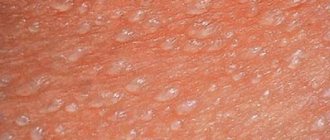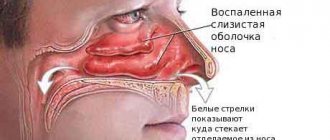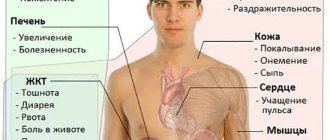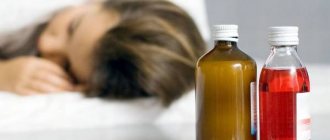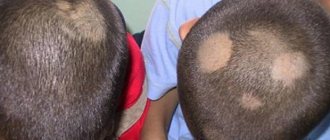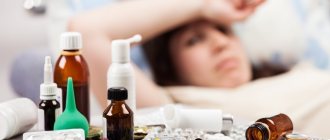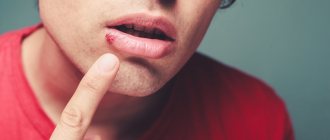Why is dermatitis dangerous?
If the disease is left untreated, the scratched epidermis becomes very sensitive to infections that penetrate through microcracks. The skin on the affected areas becomes rough, the wounds heal with scars.
Allergic dermatitis can accompany other manifestations of allergies - asthma, hay fever, etc.
Skin depigmentation is visible due to the fact that wound healing occurs with the participation of connective tissue.
Psychological discomfort is felt, self-doubt, isolation, and an inferiority complex develop.
Forms of the disease
- Acute form. It is characterized by pronounced and vivid symptoms - itching, redness of the affected areas, papules, burning, swelling.
Acute form
- Chronic form. The symptoms are not pronounced, there is constant swelling, inflammation, a change in skin color to bluish, the affected skin thickens.
Chronic form
Photo of atopic dermatitis on hands
Manifestation on different parts of the body
Main localizations:
- Face and neck (swelling, rashes, itching, redness).
- Eyelids (sticky transparent discharge, painful irritation, moist or dry skin, swelling).
- Hands (dryness, keratinization and redness of the skin).
- Legs (rash, itching, redness).
- Abdomen and back (swelling, blistering, redness)
- Groin and genitals (the lesions have a yellow-pink or pale red tint, are accompanied by severe burning and itching, urination may be painful due to the appearance of microcracks).
Red dermatitis or lichen planus
It can occur against the background of a disruption of the nervous system, a consequence of viral diseases, after trauma to the oral mucosa, it is inherited, after taking certain medications, it affects gastrointestinal diseases.
Symptoms of the disease:
- severe itching;
- the appearance of white plaques on the tongue;
- the appearance of crimson-red or pink-violet nodules on the skin;
- plaques and nodules tend to become covered with scales;
- localization of rashes on the penis and in the vestibule of the vagina;
- the appearance of purple plaques on the lips, which peel and have a grayish-white mesh.
This type of dermatitis usually affects the wrists, armpits, groin area, creases of the forearms, and inner thighs.
Note! Any sign indicating a disease is a reason to consult a specialist.
Types of Dermatitis
Seborrheic
This is an inflammation of areas where there are sebaceous glands. Externally, it manifests itself in the form of compactions, severe itching, peeling and the formation of white-yellow scales. Papules appear on the nasolabial folds, forehead and cheekbones. Often they also spread to the scalp, and at first the disease looks like regular dandruff.
The disease is provoked by a saprophytic fungus, which, when favorable conditions are created for it, begins active reproduction.
Allergic contact
It is localized in areas that have had contact with the allergen, and can sometimes spread to other areas. The intensity depends on the chemical activity of the allergen and the duration of contact with it. First of all, delicate areas of the skin are affected: cheeks, nasolabial folds, abdomen, elbow and knee bends.
Professional
With occupational dermatitis, the hands are most often affected. The site of inflammation becomes covered with blisters, turns red, severe itching and swelling appear. The rupture of the blisters leads to pronounced erosions. Symptoms are more pronounced in young patients.
Dermatitis in children (diathesis)
Dermatitis in children is associated with metabolic characteristics; at the first signs, it is treated by eliminating contact with irritating factors: bad diapers, poor-quality underwear or clothing from which it is not possible to rinse aggressive powder particles. This type of disease is commonly called diathesis.
In chronic form, the tendency to inflammatory reactions develops into atopic dermatitis. In children, it spreads throughout the body: the scalp, face, chest, abdomen, back, and limbs are affected (especially in bends).
Oral
The oral form of dermatitis appears as pink or red patches on the face. The affected areas are characterized by itching, burning and peeling.
In all cases, with prolonged exposure to allergens, changes in the skin appear - it becomes hard, dry, and keratinized.
If the disease has developed to a chronic form, then even if the patient’s condition is satisfactory, some areas remain dry and detachment of the epidermis is observed.
Causes of dermatitis
The appearance of the disease may not be directly related to the effect on the skin (distant causes). The disease is provoked by the following factors:
- predisposition - the disease is inherited at the gene level. In a third of newborns, the cause of dermatitis is parental allergies. In adults, this connection cannot be traced, and therefore diagnosis is difficult;
- acquired tendency - half of the people suffering from dermatitis did not have parents who suffered from allergies. In such people, diagnosis is difficult and it is difficult to establish what causes dermatitis in each particular case. Their predisposition is associated with a weakened immune system;
- diseases of the nervous system, neuro-emotional shocks, increased psychological overload lead to disruptions in the functioning of the endocrine system and, as a result, dermatitis;
- chronic diseases of the stomach, intestines, pancreas and liver, HIV, diabetes mellitus - all diseases associated with a steady decrease in immunity become the cause of increased allergization.
Factors also cause the occurrence of dermatitis.
Chemical origin:
- medications;
- special chemicals - acids, alkalis, fuels;
- household chemicals - detergents and cleaning products, powders;
- cosmetics - lipstick, mascara, creams, perfume, shampoo;
- building materials - paints and varnishes, adhesives.
Biological origin:
- chronic diseases;
- stress.
Physical origin:
- solar radiation;
- contact with animals;
- entry of plant pollen into the respiratory tract and onto the skin;
- exposure to high/low temperature;
- radiation exposure;
- insect bites.
Local treatment of dermatitis with ointments and creams
Dermatitis on the face and other areas of the skin requires treatment with ointments and creams. Corticosteroids (hydrocortisone ointment) are used in the treatment of severe processes. For maximum effect, you need to take breaks twice as long as the treatment period. If the disease is accompanied by microbial infections, antimicrobial drugs are prescribed.
Doctor's advice
In addition to drug treatment, lifestyle and nutrition play an important role in the treatment of dermatitis. Fresh vegetables and fruits, sleep at least 7 hours a day, lack of stress and at least half an hour walks every day help the epidermis heal faster. The sea and mud are indicated for chronic dermatitis without exacerbation or during a subsiding process.
Victoria Druzhikina Neurologist, Therapist
Antihistamines relieve itching and burning. At the acute stage, nonspecific anti-inflammatory medications are used in parallel to destroy tumors on the skin. These drugs include doxorubicin, cyclophosphamide and fluorouracil.
Ointments for dermatitis are made based on a mixture of petroleum jelly and anhydrous lanolin. Creams have a similar structure, but contain water, which evaporates upon contact with the skin, providing a cooling effect. Creams have a more gentle effect, so they are more often prescribed to children and adolescents.
Effective ointments and creams:
- Cynovit is a zinc-based product (zinc pyrithione). It soothes, moisturizes and nourishes the skin. The drug eliminates the possibility of overdose. It is possible to treat all forms of dermatitis, as well as dandruff, irritations, etc. Among all the products, the drug “Cinovit” has the largest number of positive reviews.
- Triderm is a complex drug containing clotrimazole, betamethasone and gentamicin. In addition to eliminating symptoms, these components kill microbial and fungal flora.
- Apilak is an antipruritic and anti-inflammatory agent based on lyophilized apilak. It treats dermatitis and stimulates the regeneration of the integument, so after using Apilak there are practically no scars left on the affected areas.
- Aurobin is an effective topical treatment for symptoms in the genital area.
- Belogent is a broad-spectrum product. It even copes with secondary infections and acute dermatoses of an allergic and non-allergic nature.
There are other drugs. The most popular and accessible: Exoderil Beloderm, Prednisolone ointment, Lorinden, Oxycort, etc.
Main symptoms
A few decades ago, atopic dermatitis mainly affected children, but today this disease is common among adults. And, nevertheless, if dermatitis occurs in an adult, then only in one who suffered from this disease in childhood.
Atopic dermatitis
Even if a person has a history of heredity, this does not mean that he will necessarily have dermatitis. For the development of atopic dermatitis, exposure to several external factors, which were listed above, is necessary.
Let's look at the symptoms of the disease:
Atopic dermatitis
Severe itching, burning, redness and pain in the area of the affected skin;- The appearance of swelling, erythema;
- The appearance of papules with serous fluid, which burst and merge into large lesions, erosions, weeping ulcers, then they dry out and become covered with scales;
- Excessive dryness of the skin, possible cracking;
- With mechanical trauma to the skin, swelling, hyperemia, papules, and possibly a painless callus may be observed;
- When exposed to cold, cyanosis, hyperemia and itching may occur, which without timely treatment can lead to atrophic changes.
Treatment of dermatitis in children
Severe rashes, irritation, inflammation and blisters are removed with topical medications:
- Glucocorticosteroid group. Medicines of this type are used only under medical supervision. The drugs “Hydrocortisone” and “Prednisolone” have a weak effect, while “Beloderm” and “Flucinar” have a stronger effect. A powerful ointment of a new generation - “Dermovate”.
- At an early age, corticosteroid ointments are also used.
The Ministry of Health identifies and recommends two drugs from the general list that can relieve dermatitis and provide comprehensive treatment - Elokom and Afloderm:
- Afloderm is suitable for children from 3 to 6 months and can be used on the face, neck, cheeks and other delicate areas. The active ingredient is alklometasone dipropionate.
- Elokom is available in the form of lotion, cream and ointment. The active ingredient is mometasone furoate. The product is recommended for children from 2 years old; it copes with different forms and stages of dermatitis, even the most complex.
Ointments and creams with hormones are not used if a bacterial infection is suspected, since they not only reduce inflammation, but also weaken local immunity. This leads to the growth of microflora and aggravation of the process.
Victoria Druzhikina
Neurologist, Therapist
Contraindications to the use of ointments for dermatitis
An absolute contraindication to the use of external agents is individual intolerance to active and auxiliary ingredients. Restrictions on the use of hormonal drugs include childhood, pregnancy, and lactation.
Glucocorticosteroids are not prescribed to patients with severe diseases of the liver, kidneys, or gastrointestinal tract. They are used with caution in old age.
The list of contraindications for non-hormonal drugs is not so wide. This is hypersensitivity to their components, age restrictions.
Negative consequences of improper treatment
Treatment errors lead to the emergence of new symptoms of the disease and the transition of dermatitis to the acute or chronic stage. In the future, damage to the eyes and sinuses is possible.
The use of the wrong drugs leads to the fact that the disease is not cured, and sometimes progresses with even greater force.
In addition, in response to incorrectly selected medications, local skin irritation, deterioration of health, dizziness, and fever may occur.
Psychologically, this is associated with the development of all kinds of complexes.
Dermatitis is best treated in its early stages. It is advisable to use complex therapy, i.e. Along with local medications, use sedative medications (Novo-Passit, Valerian, etc.).
Strict adherence to diet and colon cleansing is recommended. Proper hygiene, as well as the additional use of moisturizing and nourishing skin care products, have a beneficial effect on treatment.
Learn more about the treatment of dermatitis from the video:
This article has been verified by a current qualified physician, Victoria Druzhikina, and can be considered a reliable source of information for site users.
Rate how helpful this article was
5 Voted by 1 person, average rating 5
Did you like the article? Save it to your wall so you don’t lose it!
Dry dermatitis and its symptoms
People with dry skin, as well as those who are prone to allergic reactions and the elderly suffer from this disease.
Remember! Dry dermatitis very often occurs during the cold season or during severe drought.
The cause may be cold or drought, dry indoor air, hereditary factors, dust, animal hair, perfumes, fungi, or an allergic reaction to food.
Symptoms of the disease:
The symptoms of dermatitis in adults and children are no different. These include:
- swelling of the skin;
- itching;
- redness;
- peeling;
- formation of pimples, blisters or blisters;
- temperature increase.
It appears most often on the skin of the feet and occurs at certain times of the year.
Remember! Leaving the disease untreated is strictly prohibited. This will lead to worsening of the condition and complications.
How to diagnose the disease
To diagnose, you need to conduct several studies:
- Clinical analysis of blood and urine, biochemistry;
- Blood test for an immunogram, the presence of antibodies to helminths and various allergens;
- Sometimes it is advisable to perform a biopsy - plucking off a small area of skin for histological analysis, as well as to determine the nature of the pathology - fungal, viral, bacterial (in a situation where a secondary infection of the skin has occurred);
- Examination of internal organs.
Examination of internal organs
Important! Before starting therapy for atopic dermatitis on the hands, it is necessary to conduct a thorough diagnosis and determine the root cause of the development of the pathology; only then can a correct diagnosis be made, competent and comprehensive treatment be carried out, and therefore a stable remission of the disease be achieved.
During pregnancy
Atopic dermatitis during pregnancy presents a number of additional specific difficulties.
Treatment of the described pathology during pregnancy is associated with the following problems:
- In pregnant women, a standard set of medications causes negative processes in the body, which are dangerous, first of all, for the fetus. – In the first trimester, almost any pharmaceutical treatment is highly discouraged.
- Mom's diet. – Pregnant women experience major changes in hormonal levels, which sometimes intensifies the manifestations of dermatitis. – For nursing mothers, it is important to prevent eaten allergens from entering the baby’s body through breast milk.
- At the first signs of similar skin lesions in a child after complementary feeding has been introduced, an urgent adjustment of additional nutrition is necessary. – Some doctors advise keeping the baby on breast milk until the last moment, others believe that it is necessary to select adequate soy formula.
Diet therapy
A major role in the treatment of this pathology is played by following a diet that will help normalize the functioning of internal organs and reduce the effect of food allergens.
It is necessary to limit the consumption of the following foods in your diet: seafood, eggs, citrus fruits, chocolate, strawberries, marinades and sauces, tomatoes, carbonated and alcoholic drinks, sausages.
You can eat cereal soups and porridges, dried fruit compote, whole grain bread, steamed vegetables, baked apples, vegetable oils as a dressing for vegetable salads.
The main methods of treating atopic dermatitis
As stated above, atopic dermatitis can be cured in several ways. Eliminating the inflammatory process is not so difficult if you use high-quality and potent drugs.
Despite the fact that pharmacies offer a huge number of medications, you need to choose the most suitable drug among them. Some medications can harm other internal organs. Therefore, in this case, it is extremely important to listen to the opinion of experts.
First, professional dermatologists determine the extent and form of the disease in order to prescribe appropriate treatment. The first step to recovery is to identify the allergens that contribute to the skin disease. Accordingly, after the results obtained, the specialist prohibits the consumption of certain products.
In frequent cases, an allergic reaction occurs from food. In this case, the patient will have to follow a strict hypoallergenic diet. When coming into contact with chemicals, dyes and other products, it is imperative to use special gloves that will protect sensitive skin from any skin disease.
Many women complain that after wearing metal jewelry, a rash appears on their hands. In this case, it is necessary to abandon such accessories so as not to aggravate the situation. The most effective way to get rid of atopic dermatitis is drug treatment. However, the treatment course should be carried out under the supervision of a professional physician. Since in such a case, drugs are prescribed for both internal and external use.
Baths
Water treatments and baths are very important during exacerbations. The skin is cleansed, resulting in better absorption of medications. The main thing is that the water should not be warm, but not hot. It is better to fill the bathtub in advance and let it sit for a couple of hours. water is .
Starch baths
are considered useful for atopic dermatitis . Just 50 g of starch, pre-diluted in hot water, is enough. Recommended for severe itching.
Baths with salt have an anti-inflammatory effect. Dilute 100-200 g of sea salt in water, this will be enough. The main thing is to use plain salt without flavorings or dyes.
General recommendations:
- wash for no longer than 15 minutes;
- do not use washcloths or rub the affected areas;
- the water temperature should be below 37 degrees;
- You should wipe yourself off after completing the procedures very carefully.
Therapeutic baths are used in the complex treatment of the disease, but are not able to rid you of it on their own.
Cosmetics and care products
Some cosmetics contribute to the appearance or exacerbation of inflammatory processes in atopic dermatitis. The attending physician, after the diagnosis, may limit the patient from using conventional cosmetics and anti-aging creams.
Recently, the direction of cosmeceuticals has been actively developing - these are special medicinal cosmetics that improve the condition of the skin and can be used in the complex treatment of neurodermatitis.
The choice of products in pharmacies is quite large: skin care programs are sold, including shampoos, milk, cleansing water, bathing emulsions and creams. These products do not contain dyes or flavors and can be used without restrictions .
These products prevent the penetration of allergens and contain palm oil extract, zinc gluconate and other components that have a calming effect. Popular kits: TriXera from Avene, Atoderm from Bioderma and others.
Moisturizing and hygienic care is necessary for the treatment of atopic dermatitis. This will prevent the development of infections and prolong the remission of the disease.
Preparations for external use
Dermatitis on the hands is often accompanied by itching, which gets worse at night. Many patients complain of waking up in the middle of the night and being unable to fall back to sleep. In such cases, it is recommended to wear cotton gloves before going to bed and take a light herbal sleeping pill.
Acute inflammatory process is relieved with glucocorticoid ointments or creams. Depending on the severity of the lesion, the use of drugs of weak or moderate effect is prescribed. If skin lesions spread and affect not only the skin of the hands, but also other parts of the body, the use of strong hormonal drugs is necessary. Since dermatitis on the hands is accompanied by swelling and burning, patients are often prescribed creams. Due to their structure, they have a cooling effect, which helps reduce swelling, and a rapid antipruritic effect. Weak hormones include hydrocortisone, and moderate hormones include prednisolone, fluocortolone, and prednicarbate. Glucocorticoid creams are used for a limited amount of time, usually no longer than a week.
Relieving acute inflammation is only the first step of therapy. The chronic stage is also characterized by itching (albeit not as intense) and, most importantly, dry skin. Dryness provokes peeling and cracks that interfere with the healing of the skin. To normalize metabolic processes in the skin, including water balance, it is necessary to resort to additional hydration. The greatest effect comes from applying creams after hygiene procedures. Under the influence of warm (but not hot) water, the epidermis softens, and the crusts dissolve and come off.
However, it is worth noting that washing your hands with soap will most likely lead to a negative result, since alkali dries out the skin and, once it gets into the wounds, causes tingling and exudate. Delicate care is provided by special medicinal and cosmetic care products for inflamed skin. Thus, “Losterin” body gel, which can also be used as hand soap, does not contain surfactants, fragrances or dyes. And 4 types of vegetable oils in its composition, deresined naphthalan and Japanese sophora extract provide both cleansing, bactericidal effect, and moisturizing of the skin. In the acute period, it is recommended to cleanse the skin of the hands with micellar water and clean soft wipes.
After water procedures, the skin is carefully blotted (do not wipe!) with a towel and moisturizer is applied. For hand skin dermatitis, creams containing vegetable oils and panthenol are useful, which create a thin fatty film on the surface of the skin and do not allow the liquid to evaporate. Vegetable oils can be applied to the skin in the form of lotions, or they can be included in creams. Traditionally, olive, flaxseed, sea buckthorn, sunflower oil, avocado and jojoba oils are used in dermatology. In addition, products with the addition of plant extracts and vitamins are needed. These components provide nutrition to skin cells and accelerate regeneration. Preparations containing tar, naphthalan, salicylic acid, and zinc help relieve skin itching.
The restoration of epithelial cells is facilitated by preparations with propolis. This natural remedy has desensitizing, anti-inflammatory and regenerative properties due to its composition. Propolis contains flavonoids, aromatic and fatty acids, free amino acids, proteins, alcohols, minerals, sugars, vitamins, steroids, and many microelements. However, ointments, sprays and creams with propolis can be prescribed only to those people who are not allergic to honey and pollen. In other cases, the product may cause a severe allergic reaction.
In most cases, chronic dermatitis on the hands can be treated with external herbal medicine. It can be combined with hygienic procedures. For example, after an evening shower, it is useful to take hand baths with extracts or infusions of pine needles, chamomile flowers, oak bark, calendula, birch buds, string, burdock root, plantain leaves, poplar buds, and lungwort. After a 10-minute bath, the skin of the hands is also dried with a towel and moisturizer is applied.
Causes of the disease
The causes of atopic dermatitis are still completely unknown. In the disease development scenario, the main processes occurring at the immunological, biochemical and physiological level have been identified.
The main reasons for the development of the disease:
- genetic predisposition is one of the main factors; the risk of getting sick increases 3-4 times if both parents of the patient suffer;
- regular exposure to chemical agents that objectively have irritating properties, for example, construction paints or solutions;
- similar exposure to agents considered “classical allergens” (pollen, poplar fluff, wool);
- diseases or drug therapy that disrupt the functions of the endocrine glands, and therefore hormonal levels (diabetes, Graves' disease, hormone therapy, chemotherapy);
- unfavorable environmental conditions: continental climate, polluted industrial-urban environment;
- unfavorable lifestyle: poor nutrition, insufficient sleep, regular stress, smoking, alcoholism.
The prevalence of the disease is highest in extremely harsh industrial conditions, where severe urban and industrial pollution are combined. These are large cities in the USA, Russia, and China. In Russia, an unfavorable factor is added in the form of a sharply continental climate in many regions.
Patterns of disease development under the influence of external negative factors have been poorly studied. It has been determined that the increased content of trans fats in regularly consumed foods (chips, fast food) increases the risk of occurrence by at least 20%.
Losterin cream for the treatment of dermatitis on the hands
Natural remedies must be used every day for several weeks or even months, depending on the severity of the disease. It is important that they do not have synthetic fragrances, and that their active components quickly penetrate deep into the epidermis. These requirements are fully met by the “Losterin ” cream, intended for daily care, moisturizing and protecting the skin of the hands.
Almond oil regulates water balance. Sophora japonica extract reduces the intensity of inflammation and peeling, and deresined naphthalan is a natural product that has been used in the complex treatment of dermatitis for more than 100 years. Naftalan has bactericidal, vasodilating and regenerative properties, and in combination with urea and salicylic acid it has a powerful antipruritic effect. For hygiene procedures, people with dermatitis are offered the “Losterin” shower gel, which does not contain alkali, does not irritate the skin and has a desensitizing effect.
Diet for dermatitis
For dermatitis of various natures, there are general lists of permitted and prohibited products:
Permitted ones include:
- apples and pears;
- melons;
- zucchini and cabbage;
- any lean white meat;
- fermented milk products with caution;
- vegetable oils (exception: peanut and sesame);
- various cereals and cereals (except chickpeas and peas).
Prohibited items include:
- red meats;
- milk and dairy products;
- any citrus fruits;
- pineapple and berries;
- eggs;
- mushrooms;
- any nuts;
- bee products.
Folk remedies for internal use
To treat dermatitis with folk remedies, tinctures of various herbs with the addition of alcohol are prepared, which can be either taken orally or treated externally on the affected areas. They should be consumed in small portions (0.5 - 1 tsp several times a day, washed down or stirred in water), and also remember about a possible allergic reaction to some types of herbs.
One of the cooking recipes involves preparing an infusion of:
- leaves and flowers of black elderberry in the amount of 10 g;
- calamus root – 15 g;
- St. John's wort herbs -10 g;
- elm bark – 10 g;
- elecampane root – 5 g.
All herbs are finely chopped, poured with half a glass of boiling water, infused for 24 hours and filtered. Next, the infusion is brought to a boil and 100 ml of vodka is added to it. The prepared infusion is left to brew (about 10 hours) and drunk 1 tsp. 2 times a day, stirring in half a glass of water.
Also, to treat dermatitis or eczema, you can use an infusion of Sophora japonica fruits, poured with boiling water in a ratio of 1:10 and left overnight. The tincture is taken in the morning, preheated.
Causes
Dermatitis on the hands in adults can be caused by various reasons. Their development is determined by external or internal stimuli, which are divided into categories.
Food. Dermatitis on the hands can be caused by highly allergenic foods. This category often includes:
- chocolate;
- strawberry;
- peanut;
- citrus fruits, etc.
We recommend: cherry allergy: symptoms and treatment
Medicinal. Drugs of various groups can cause dermatitis on the hands of adults. These include dietary supplements, anti-inflammatory drugs, antibiotics, etc.
Physical. The manifestation of dermatitis can be triggered by mechanical or other contact. Physical dermatitis is often caused by:
- application of pressure;
- UV irradiation;
- friction, etc.
Chemical. This broad group includes:
- many building mixtures;
- solvents;
- varnishes and paints;
- wallpaper glue;
- cosmetics;
- household chemicals, etc.
Biological. Drugs, plants, and natural ingredients are among the biological causes of dermatitis.
Genetic predisposition. Hereditary predisposition, which is adopted from previous generations, can cause the development of dermatitis. This disease can appear in childhood.
Diseases. Dermatitis on the hands of adults may be caused by diseases of the gastrointestinal tract and endocrine system. Treatment of the very cause of dermatitis can affect the elimination of unpleasant manifestations on the hands. Nerve problems, hormonal surges and disruptions can also contribute to dermatitis.
Cross allergy table
Symptoms of perioral dermatitis on the face and eyelids
Photos of symptoms of perioral dermatitis, especially in adults, show how treatment can improve facial skin after allergies to cosmetics such as foundation or silicone makeup base.
With daily use, the substances contained in cosmetics, due to penetration into the pores during the day, are difficult to wash out and accumulate, creating points of active pollution.
The body reacts accordingly: the immune system gives a signal in the form of a rash with redness. Often the rash is accompanied by itching, which can lead to secondary infection with the appearance of suppuration or blisters.
Which doctor will help?
People faced with atopic dermatitis begin to think about how to treat it.
And young men of military age are interested in whether they are accepted into the army with such a disease.
The following specialists will help you deal with these issues:
- dermatologist;
- immunologist-allergist.
In the event of a severe secondary infection, the formation of a fistula or carbuncle, assistance is required:
- infectious disease specialist - often a person first goes to him to determine whether he is contagious or not, because many people initially mistake dermatitis for some kind of infection;
- surgeon
And if the patient’s disease is caused by a food allergy, then a diet and consultation with a nutritionist will also be necessary.
In case of dermatitis, or when there is eczema, whose etiology is endogenous, a conscript can receive a military ID with category “B” (limitedly fit) and “D” (not fit).
However, if atopic dermatitis is in sufficient remission, i.e. There hasn’t been a single exacerbation for the last 3 years, the situation is getting more complicated. It’s even worse if the conscript’s medical history is not complete enough. Those. there are no records in the medical record about constant observations from the attending physician, there is no epicrisis from the dermatovenerological dispensary (DVT).
To obtain at least category “B”, you must:
- in the last 3 years there has been at least one severe exacerbation or several moderate ones, and in honey. the card must contain complete data about them;
- moderate manifestations of the disease at the moment, the skin should not look completely healthy, either diffuse, moderate rashes over a large area or a clearly visible lesion in a limited area, for example, on the wrist, are required.
Category “D” is given for regular severe exacerbations with an interval of 7-8 months or less, with large areas of skin lesions and severe lichenification.
Consultation with a dermatologist
Atopic or atypical dermatitis in adults can cause serious changes in lifestyle. But the final diagnosis is made by the attending physician.
Self-medication is not recommended. As already mentioned, 80% of the study of this pathology is dermatovenereology. Here, the dermatologist is the doctor who approves the final diagnosis and determines the course of treatment.
Allergist consultation
The advice of an allergist or immunologist is just as important as that of a dermatologist. After all, in fact, it is the immunologist who analyzes the key mechanisms.
This specialist provides consultations, for example, regarding hormone therapy, taking immunosuppressive drugs, and special aspects of allergic reactions.
Hormonal creams description and application
Treatment of dermatitis with ointments based on hormonal agents occurs when other medications do not have a positive effect. In addition, they can cause a number of side effects, which is why the adult patient and the child may experience the following negative reactions:
- skin atrophy appears;
- hair loss;
- pigmentation of the spot or persistent erythema (redness) occurs.
To treat advanced forms of dermatoses, the following hormonal agents are prescribed.
Flucinar
The active substance is the chemical compound Fluocinolone acetonide. Citric acid, petroleum jelly and Lanolin are used as additional ingredients in production. This drug allows you to get rid of clinical manifestations (allergic reactions, psoriatic rashes), and also eliminates the symptoms of eczema and lichen.
In order for the treatment to have the desired effect, the medication is applied 2 to 4 times within 24 hours. Sometimes an occlusive dressing can be used. The drug is not used in any trimester of pregnancy, for herpetic rashes and skin forms of tuberculosis. Children are allowed to take from the age of two.
Celestoderm
The therapeutic effectiveness is explained by the presence of Betamethasone. The product is recommended to be prescribed for such pathological conditions as eczema, any form of psoriasis, diaper rash or itchy skin. Systematic use provides anti-inflammatory and regenerating effects. Children from 1 year of age are allowed to use it. The treatment course should not exceed ten days, applying the ointment twice a day.
celestoderm dermatitis cream packaged
Advantan
A type of hormonal ointment whose main ingredient is Methylprednisolone aceponate. The drug softens and moisturizes the skin well, providing an anti-inflammatory and anti-allergic effect. Various types of dermatitis, psoriatic rashes and neurodermatitis are the main areas of application of this medication. The dosage form Advantan is approved for use from 4 months of age. It is not used in the following situations:
- Tuberculous and syphilitic lesions of skin areas.
- Rash due to shingles or chickenpox.
- When any ingredient causes an allergic reaction.
Fucicort
The main components are 2 components Fusidic acid and Betamethasone. A positive effect is observed when used for seborrheic, contact, allergic and atopic dermatosis. The drug has an extensive list of contraindications for its use, and the duration of the course is agreed with the doctor. The usual dosage is to apply the ointment twice a day (for a two-week period).
Akriderm
A hormonal drug based on the component Betamethasone dipropionate. Quickly penetrates into the source of inflammation in all types of dermatoses. Also used for eczema and psoriasis. Sometimes prescribed for fungal skin diseases. To avoid unpleasant sensations when applying the ointment to the skin, you should avoid getting it on the mucous membranes.
ointments for dermatitis
The duration of therapy should not exceed 3 weeks with a frequency of use up to 3 times a day. Complete contraindications include skin tuberculosis, hypersensitivity, vaccination and any trimester of pregnancy.
External folk remedies for rubbing
The fruits of Sophora japonica are a universal remedy for combating the manifestations of dermatoses, so you can prepare an alcohol tincture from them by first pouring 2 tablespoons of crushed seeds into 1 liter of vodka. The tincture is kept for 10 days in a dark place, stirring occasionally, and rubdowns are performed in areas of uncomplicated dermatosis.
Irritation and itching of the dermis will help eliminate a decoction of the string, prepared from 60 g of dry herb and 250 ml of boiling water. The herb is poured with boiling water and placed in a water bath for 20 minutes, after which the liquid is allowed to cool. After 10 minutes, filter the broth and mix with 2 liters of warm water.
This mixture is used for rubbing, and after the procedure they take a shower using tar soap. It is recommended to repeat wiping every 3 days until signs of dermatitis disappear.
Moisturizing ointments for allergic dermatitis
During the period of remission of the disease, the healed areas of the skin are lubricated with creams and ointments that help restore the skin structure and protect it from negative environmental influences. The simpler the composition of the product, the greater the chance that the disease will not return again.
Physiogel AI is a cosmetic product that normalizes the water balance of the skin, stimulates the formation of collagen and eliminates the remnants of the inflammatory process (redness, peeling). Nourishing cream is applied to clean skin after water procedures. Patients note that the product is easy to apply, odorless, quickly absorbed and does not leave a greasy residue on the skin.
Radevit ointment, which contains vitamins A, E and D2, has healing and dermatoprotective properties. Active components nourish dry skin, protect against aggressive environmental influences and have a calming effect. The drug is not applied if there are signs of hypervitaminosis (A and D), excessive activity of the sebaceous glands and pregnancy.
It is impossible to cure allergic dermatitis with ointment, cream or gel alone. Doctors take a comprehensive approach to eliminating the symptoms of the disease in order to prevent the development of complications. Self-medication in this situation is unacceptable, due to the fact that drugs with numerous side effects are used to treat allergic rashes.
Prevention
The most effective prevention is to protect the patient from the irritant. If there is no contact with the allergen, then there will be no reason for the development of the disease.
Experts also recommend adhering to the following recommendations:
- In contact with household chemicals, harmful substances, paint, etc. Wear protective gloves on your hands.
- When choosing cleaning products and detergents for personal hygiene, choose brands with the most gentle composition. The fewer impurities in the product, the better.
- Choose laundry detergents, soap, and personal hygiene products for children. They are not allergenic and do not dry out the skin.
- When you are outside in cold weather, wear warm gloves and mittens. Don't let your skin freeze.
- To protect your hands from ultraviolet rays, apply moisturizer or sunscreen to your hands before going outside.
- Choose hand soap with a moisturizing effect.
- Apply moisturizing and nourishing cream to your hands daily, morning and evening.
- As a preventive measure, make baths with yarrow or chamomile infusion once a month.
So that your hands are always soft and gentle. Use moisturizers designed for brushes. Treat the skin on your hands with care, as it is very sensitive and requires additional care. You should only wash dishes and come into contact with harmful substances wearing protective gloves!
Dermatitis is a disease that can occur in any person upon contact with various irritants. The disease is highly treatable and rarely causes severe complications. Therefore, when the first signs of the disease appear, you should consult a doctor and begin conservative treatment. Only timely treatment can protect you from possible health problems.
Treatment of dermatoses with homemade ointments
Honey and Kalanchoe juice for skin diseases
To prepare, take equal parts of these ingredients, mix them, and leave to brew for a week. After this, apply twice within 24 hours. To improve the effect, it is recommended to add aloe juice (in the same concentration).
Sea buckthorn oil and rendered lard for allergic inflammatory processes of the epidermis
Melted lard (50 ml) is mixed with two tablespoons of sea buckthorn oil. The resulting composition relieves the feeling of irritation and itching.
Grated potatoes for dermatosis
Raw potato tubers are grated on a fine grater with the addition of fatty sour cream (ratio 1:3). It is recommended to use 3 times a day at equal intervals.
folk treatment of dermatitis with grated potatoes
Symptoms of dermatitis
The development of pathology is accompanied by the manifestation of visible symptoms. Dermatitis on the fingers is characterized :
- The appearance of redness in the area of irritation.
- Hands swell.
- In severe cases of pathology, watery blisters with cloudy liquid appear on the body.
- After the blisters burst on the skin, erosive areas appear on the dermis.
- Severe itching.
- Dry hands.
- Crust on damaged areas.
- A bluish area of the dermis.
Simple contact dermatitis in the normal course of the disease does not cause complications. The only thing that can happen in this case is severe damage to the skin. There may be scars or welts on your hands. In some cases, pigmentation or calluses may appear.
With prolonged development of the disease and exposure to the allergen, severe complications and consequences are possible. If proper treatment is not started, then the formation of necrosis, deep damage to the epidermis, infectious or viral infection, and the development of fungus are possible. In severe cases, the development of eczema and sepsis is possible.
Symptoms
As a rule, the disease develops suddenly, resulting in severe inflammation in children and adults, which is manifested by the following symptoms:
- the patient suffers from severe itching of the skin, burning and pain at the site of the lesion, which is bright red or pink (pictured);
- Erythematous edema may appear, the intensity of which can fluctuate between strong and weak, depending on the severity of the disease. In cases where signs of chronic dermatitis are observed, the swelling is most often stagnant;
- symptoms of severe disease are accompanied by blisters filled with serous contents. When opened, the bubbles can merge into single necrotic areas, turning into weeping erosion. Subsequently, it becomes covered with crusts and scales;
- There is increased skin dryness and flaking (pictured). Due to the fact that the skin is dry, it may crack;
- if the diseases are provoked by mechanical irritation, abrasions, watery blisters, and swelling are observed in the hyperemic areas. Sometimes dermatitis on the skin of the hands occurs in the form of hyperkeratosis (painless callus). This is due to the increased sensitivity of the skin to irritating agents.
In addition, when exposed to low temperatures, cold dermatitis may develop, causing red-blue swelling and severe itching. It is important to note that in the absence of adequate therapy, especially in a child, atrophy of the epidermis is possible.
